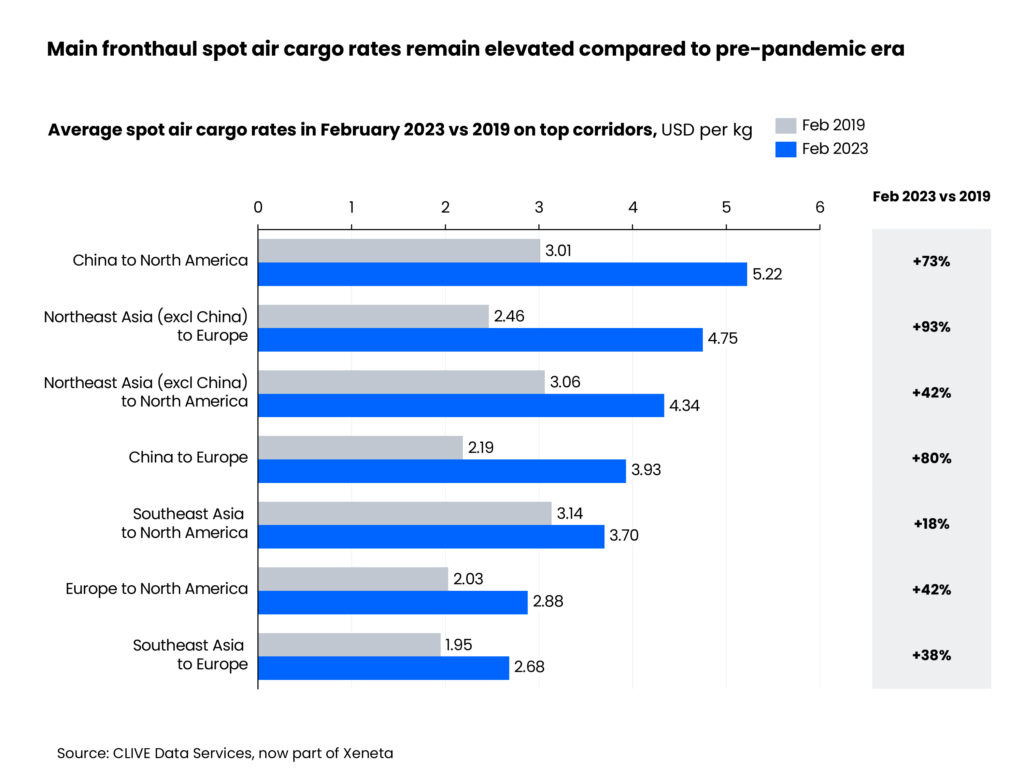Air cargo capacity rises above pre-pandemic level while industry faces risk of zero growth30 March 2023
Air cargo capacity is continuing to climb and rose above the pre-pandemic level for the first time in four years, according to the latest market analysis from CLIVE Data Services. Global air cargo capacity increased for the eleventh consecutive month in February, up 11% on the same period last year. Meanwhile, global air cargo volumes fell 4% year on year and rates stabilised. Niall van de Wouw, chief airfreight officer at Xeneta, warned that “we might still be seeing zero overall growth for general air cargo by later in the year”. He said the latest data means it’s time for the industry to let go of pre-Covid comparisons and to acknowledge a new baseline for air cargo market growth. “CLIVE Data Services was one of the first industry analysts to benchmark data versus the pre-pandemic level because a comparison was needed at the time to accurately measure air cargo’s performance. But the fascination and rhetoric around airfreight rates going back to the 2019 level needs to be replaced based on the inflationary components we now see. “Name me a service or product that you acquired four years ago that you’re still paying the same price for now? The air cargo industry should be focused on where growth is going to come from because the general air cargo volumes have seen negative growth for four years, and based on the first two months of 2023 are still down 8% in terms of chargeable weight compared to four years ago. That is not a growth market.” He noted 2019 was also a relatively weak year for air cargo after a buoyant 2018. He added: “The volumes are not there, flights are less full, and more capacity will be coming in April as summer flight schedules commence, so I don’t see fundamental changes that will help the current market conditions. “There is a hope and expectation of volumes increasing in Q3 as companies restock, but when I talk to shippers, I don’t hear anyone saying they’re going to ship more airfreight. If restocking comes, many shippers will look firstly to use cheaper modes of transport and, from where we are now, even if there is a boost, we might still be seeing zero overall growth for general air cargo by later in the year.”
Asia Pacific (APAC) to Europe, Southeast Asia to Europe, APAC to North America and Europe to North America spot rates remained above the pre-pandemic level. Spot rates from China and other Northeast Asian regions remained elevated. Labour shortages and industrial action continued to present industry challenges. The recent strikes in German airports on February 17 had a profound impact on air cargo capacity. Outbound Frankfurt cargo capacity on the day of the strikes fell a sharp 60% compared to the week prior. Elevated transportation, fertiliser and labour costs, as well as consumers hit by the cost-of-living crisis, meant that flower shipments during the traditional February surge period suffered from dampened cargo volumes on some routes, e.g. Kenya and Ethiopia to Amsterdam, but flower cargo volumes from Colombia and Ecuador to Miami stayed strong.
By: Rebecca Jeffrey |
|
   |
.jpg)

